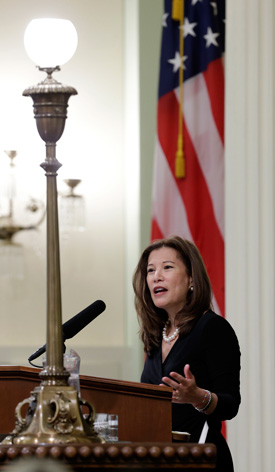Court chief highlights judiciary’s efforts to overcome funding
gap
By Amy Yarbrough
Staff Writer
Addressing lawmakers in Sacramento last month, Chief Justice
Tani G. Cantil-Sakauye spoke of fairness, collaboration and ongoing projects to
ensure more Californians have access to justice.
 |
| Cantil-Sakauye delivers the State of the Judiciary address March 17 in Sacramento -- AP photo |
She also did not miss the opportunity to make a case for the
state’s financially strapped courts.
With the nation preparing to mark the 50th anniversary of
the Civil Rights Act this year, Cantil-Sakauye called it tragic that budget
cuts have shuttered courthouses, delaying cases and making it difficult for
many Californians just to get to court.
“As you know, the reductions have fallen hardest on the
process of civil cases. And so we face astonishing and harmful delays in urgent
family matters, in business contracts, wrongful termination, discrimination
cases, personal injury cases – across the board,” Cantil-Sakauye said during
her State of the Judiciary address
on March 17.
“Nevertheless, we continue to persevere. But it’s tragic
that 50 years after the enactment of the Civil Rights Act, California faces a
different type of civil rights crisis. It’s not about the law. It’s about
access to it.”
In the last six years, the judicial branch has weathered $1
billion in budget cuts. Fifty-one courthouses have shut their doors, 205
courtrooms have closed and 30 courts have reduced their public service hours,
among other cutbacks. Although the governor’s proposed budget for next fiscal
year recommends an additional $105 million for the trial courts, Cantil-Sakauye
has warned that the funding still falls short.
During the speech Cantil-Sakauye referenced her report
released in January called a “Three-Year
Blueprint for a Fully Funded Judicial Branch,” which concluded that the
judicial branch would need an additional $1 million just to maintain the status
quo.
Cantil-Sakauye said the report not only lays out the
judicial branch’s costs but also serves as “a reminder that court closures have
deprived at least 2 million Californians of access to a local court.
“A one-way, three-hour trip to a courthouse can’t be fair in
anybody’s book,” she said.
Cantil-Sakauye also touched on various efforts by the
judicial branch to promote fairness, projects she said are only possible
because of collaboration. Among other endeavors, California has been a leader
in the development of collaborative courts, thanks to a combination of legislative
support, executive support in grant funding, judges and lawyers and support programs
at the local level, she said.
In addition, self-represented litigants in the state now
have access to more than 100 self-help centers, made possible through the
combined efforts of lawmakers and the judicial branch.
Under a 2-year-old partnership with the state superintendent
of public instruction to promote civics learning in grades kindergarten through
12th grade, public high schools are honored each year for making civics
learning a priority. Like last year, Cantil-Sakauye said she plans to go to the
schools to personally deliver their awards.
“When I go there, I like to tell them how we all work
together and how it is that we have a judicial branch that’s 17 years young,”
she said. “I tell them that the reason we’re 17 years young is because with the
help of the Legislature and the executive branch and the voters, we were able
to condense and transition from over 220 disparate courts into 58 efficient
superior courts.”
Returning to the theme of civil rights, Cantil-Sakauye quoted
a letter that Dr. Martin Luther King Jr. sent to his fellow clergymen after
they criticized him for bringing the civil rights movement to Birmingham, Ala. His
words still ring true today, she said.
“Injustice anywhere is a threat to justice everywhere. We
are caught in a network of inescapable mutuality. We are tied in a single
garment of destiny. Whatever affects one directly, affects all indirectly,” she
said
“I would argue that that quote, 50 years later, is relatable
to the three branches of government and how we operate, and collectively serve
the public.”